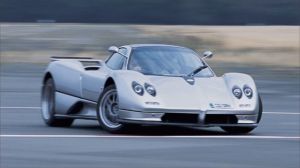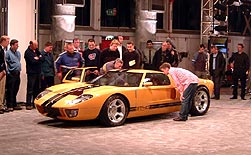Top Gear (2002 TV series)/Series 1/Episode 1
| Episode 1 (third pilot) | |||
|---|---|---|---|
|
| |||
| Prod. code | GFGA001W | ||
| No. | 1 (since 2002), 550 (since 1977) | ||
| Runtime | 58:57 | ||
| Viewers | 2.43 million | ||
| Airdate |
| ||
| Episode Chronology |
| ||
-->
Series 1, Episode 1 of Top Gear aired on the 20th October, 2002. It was the first episode of [[Top Gear (2002 TV series)/Series 1|Series 1]]; the 1st episode of Top Gear since the show's 2002 reboot and the 550th episode overall, including compilations. It was the 541st episode since Top Gear entered national broadcasting in 1978, and was the 2nd programme to air in 2002 out of a total 11. Series 1, Episode 1 was originally broadcast in 576i at a 16:9 Widescreen aspect ratio on British television channel BBC Two. The episode was presented by Jeremy Clarkson, Jason Dawe, and Richard Hammond, alongside The Stig. Harry Enfield was the Star in a Reasonably-Priced Car.
This episode marked the revival of the Top Gear name following the 2002 Top Gear Awards special in February. For the first time since 1998, the episode starred Jeremy Clarkson in the role of lead presenter.
Synopsis
As narrated by Jeremy Clarkson:
- I put two supercars head to head.
- Jason Dawe on what to do when car dealers attack.
- Richard Hammond will try to beat a speed camera.
- And there's a Star in a Reasonably-Priced Car.
Jeremy Clarkson starts off with two family hatchbacks, the Ford Focus, represented with a high-performance ST170 model, and the Volkswagen Golf. These cars are quite pricey for their segment, but are not out of the ordinary for cars of this status and level of equipment. However, Clarkson believes there is a cheaper option that will appeal the more frugal motorist.
Citroën Berlingo Multispace
Unabridged article: Citroën Berlingo Multispace Film
Enter the Citroën Berlingo Multispace. This vehicle is even cheaper than a Focus or Golf, and though it may be based on a van, that isn't a reason to discount it as viable family transport. To put its credentials to the test, Clarkson decides to drive it down the M20 Motorway towards Folkestone, so that Clarkson can drive it back home. Taking the Eurostar, he loads the Berlingo into a train car and travels to France, before disembarking at Calais. He then takes the Berlingo to a "Cash and Carry" warehouse by the name of EastEnders, operated[1] by David West. Him and Clarkson discuss why these duty-free warehouses are so popular with British day tourists, before the latter mentions that the police are cracking down on resellers by having their cars crushed. To avoid this, he purchases and places a single bottle of Blue Nun in the Berlingo's rear hatch, despite its ability to carry so much more.
Back at the studio, Clarkson, along with new host Jason Dawe discuss the Berlingo and its alternatives, with Dawe's role as the show's car-buying expert. There's the Fiat Doblò, Renault Kangoo and Ford Tourneo Connect, but these all pale to the Berlingo, either in terms of value or performance.
Ford GT40 Concept
Richard Hammond is introduced to the series for the first time by taking a look at the Ford GT40 Concept, which Ford are to put into production[2] 2 years later. This includes a brief overview of why the original GT40 was created and raced to defeat Ferrari at Le Mans, before showing off the concept's various automated electronic parts such as its rear engine cover, and automatic fuel filler cap. Hammond believes the car resembles its inspiration so much that he deems it an enlarged copy of the original.
The News
Unabridged article: The News (16th October, 2002)
In the very first edition of The News, Jeremy and Richard discuss how the British government pledge[3] to spend £145 million improving the road network for the next 5 years, which works out at a rate of 3 and a half miles every year. This is followed up by talking about Fiat's bleak near-future, where the company was then losing[4] close to £2 million every day. To try and stem this tide, they have launched an estate version of the Fiat Stilo. There's also a look at cut-price roadsters in the forms of the Nissan Micra and Smart Roadster, before dedicating the rest of the segment towards Formula 1, in light of Michael Schumacher dominantly winning[5] that year's season with still a third of the races left to run. Clarkson and the audience place blame on the increased electronic aids, where cars can be tuned wirelessly from the pit garage, and vow for Formula 1 to strip these out for future seasons.
Track Test: Murciélago vs. Zonda
Unabridged article: Murciélago vs. Zonda Film
In the world of Italian supercars, there's a new name; Pagani. With its jet-fighter styling, the company's Zonda is an unbelievably quick supercar powered by a 7.3 litre Mercedes-Benz engine prepared specifically[6] by the latter's AMG firm. Clarkson thinks the car is fantastic, considering it came from nothing, but must stack up against arguably one of the most fierce opponents imaginable; Lamborghini's newest flagship V12 halo car, the Murciélago. The latter is the first ground-up vehicle produced by Lamborghini since its acquisition[7] by Volkswagen in 1998, and there were worries the new car wouldn't feel like a traditional Lamborghini. However, with its radical styling, trademark scissor doors and screaming V12, the car more than fits the archetype set by its immediate predecessors, with the only hints of German engineering making the car easier to drive. Clarkson freely powerslides both cars across the Top Gear Test Track, before holding a drag race between the two Italians. Despite the Murciélago's blinding quickness, it is beaten by the upstart Zonda, much to Clarkson's amazement.
Airing history
For a concise, detailed report on this episode's international airing history, see Airing history.
As Top Gear was not yet as successful as it would eventually become, broadcasts of this episode were very limited, especially in its original 59 minute form. In addition, after the later success of host James May, episodes from Series 1 would become undesirable and as a result, would be pulled from the BBC World Sales Catalogue after 2009. This was likely due to the fact there were now more than 100 other episodes available for syndication.
United Kingdom
Series 1, Episode 1 would premiere on BBC Two on the night of the 20th October, 2002. Unlike later episodes of Top Gear, the episode would not be repeated following its initial airing, though it would be edited down into a 45 minute version by Red Bee Media for usage on UKTV channels such as UK Horizons, where the episode began airing approximately 2 weeks after its premiere on BBC Two.
Worldwide
Internationally, the episode would first premiere on BBC World on the 13th of November, 2002, 3 weeks after its UK release. It would then be shown in the Netherlands on Veronica from the 26th of September, 2003, 11 months later, before appearing on BBC Prime in November 2004, and then the likes of TVN Turbo in Poland and NTV in Russia during 2005, the latter in a similarly cut-down form to how the episode was shown on BBC World. The episode would be reshown in a handful of countries thereafter, but would not premiere in many Baltic and Balkan nations such as the Czech Republic, Hungary and Estonia until as late as mid-2009, a full six and a half years after the episode was first shown in the United Kingdom.
Further reading
This article is intended serve as a basic summation of all the content depicted within Series 1, Episode 1, and deliberately omits or abridges certain details in order to ease reading comprehension and reduce overall page length.
For a fully detailed, in-depth analysis of this episode, please visit Top Gear (2002 TV series)/Series 1/Episode 1/Unabridged.
References
- ↑ BBC News - Has The Booze Cruise Come To An End?
- ↑ New Atlas - GT40 Race Replica Roadster to go into production.
- ↑ Parliament - Regional Development Agencies.
- ↑ The Guardian - Sergio Marchionne.
- ↑ Motorsport Magazine - 2002: The Year Michael Schumacher Described As 'Perfect'.
- ↑ (Archive link) Pagani Automobili - Zonda.
- ↑ Automotive News Europe - VW's Audi Agrees To Buy Lamborghini.
| |||||||||||
- Episodes
- Episodes of Top Gear
- Episodes of Top Gear (2002 TV series)
- First Episodes
- First Episodes of Top Gear
- First Episodes of Top Gear (2002 TV series)
- Episodes which aired on 20th October
- Episodes of Top Gear which aired on 20th October
- Episodes of Top Gear (2002 TV series) which aired on 20th October
- Episodes which aired in 2002
- Episodes of Top Gear which aired in 2002
- Episodes broadcast in 576i
- Episodes of Top Gear broadcast in 576i
- Episodes broadcast at 16:9 Widescreen aspect ratio
- Episodes of Top Gear broadcast at 16:9 Widescreen aspect ratio
- Episodes broadcast on BBC Two
- Episodes of Top Gear broadcast on BBC Two
- Episodes of Top Gear (2002 TV series) broadcast on BBC Two
- Episodes presented by Jeremy Clarkson
- Episodes of Top Gear presented by Jeremy Clarkson
- Episodes of Top Gear (2002 TV series) presented by Jeremy Clarkson
- Episodes presented by Jason Dawe
- Episodes of Top Gear presented by Jason Dawe
- Episodes of Top Gear (2002 TV series) presented by Jason Dawe
- Episodes presented by Richard Hammond
- Episodes of Top Gear presented by Richard Hammond
- Episodes of Top Gear (2002 TV series) presented by Richard Hammond
- Episodes of Top Gear with an introduction narrated by Jeremy Clarkson
- Episodes of Top Gear (2002 TV series) that were pulled from air

